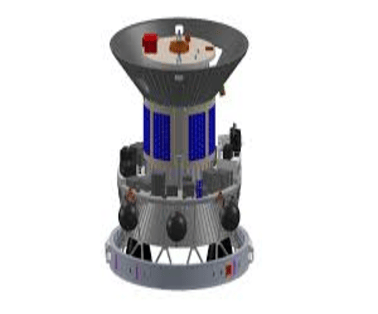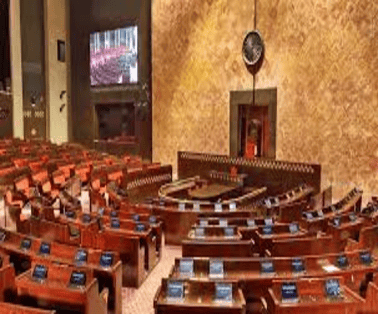The Indian Space Research Organisation (ISRO) has successfully completed its PSLV-C58/XPoSat mission, with the POEM 3 module playing a key role in ensuring minimal space debris in Earth’s orbit.
Key Highlights of ISRO’s POEM 3 Mission
- The space agency explained that the last stage of the Polar Satellite Launch vehicle (PSLV) used in the mission was transformed into a kind of orbital station
- The station called the PSLV Orbital Experimental Module-3 (POEM-3) safely re-entered the atmosphere rather than remaining in orbit after completing its mission.
- ISRO said that after it completed the primary mission of injecting all satellites into their target orbits, the fourth stage of the PSLV was transformed into the POEM-3.
- It was subsequently de-orbited from 650 kilometres to 350 kilometres, rendering it more susceptible to being pulled towards the earth and burning up in the atmosphere.
- ISRO also said it “passivated the stage,” meaning dumped its fuel, to avoid an explosion that could have flung small pieces of debris into orbit.
What Is POEM 3?
- It is developed by the Vikram Sarabhai Space Centre (VSSC) as an inexpensive space platform
- Used for the first time in the PSLV-C53 mission in June 2022, ISRO had POEM orbit the earth as a stabilised platform to perform in-orbit scientific experiments with various payloads.
- POEM is powered by solar panels mounted on the fuel tank of the rocket’s fourth stage and a lithium-ion (Li-ion) battery.
- It has a dedicated navigation, guidance, and control (NGC) system to stabilise its altitude along with helium control thrusters.
- The NGC system has four Sun sensors, a magnetometer, and gyroscopes, and talks to ISRO’s NavIC satellite constellation for navigation.
- POEM also has a telecommand system to communicate with the ground station.
- ISRO first demonstrated the reuse of the spent fourth stage of its rocket in its PSLV C-44 mission in 2019.
- After satellites were injected in the target orbits, the fourth stage, carrying a student payload called Kalamsat-V2, was moved to a higher circular orbit of 443 km and stayed there, allowing the payload to make observations.
Space Debris
- Space debris in the low earth orbit (LEO) mainly comprises pieces of spacecraft, rockets, and defunct satellites, and the fragments of objects that have deteriorated explosively as a result of anti-satellite missile tests.
- This debris often flies around at high speeds of up to 27,000 kilometres per hour. Due to their sheer volume and momentum, they pose a risk to several space assets.
- The LEO extends from 100 km above the earth’s surface up to 2000 km It includes satellites tracking intelligence data, encrypted communication, and navigation.
- According to ISRO’s Space Situational Assessment report 2022, the world placed 2,533 objects in space in 179 launches in 2022, up from 1860 objects in 135 launches in 2021.
- Debris also exists, but in smaller volumes, in the geosynchronous orbit (GEO), which is 36,000 km above the earth’s surface.
- Currently, there are 7,000 operational satellites orbiting the earth at different altitudes along with millions of pieces of space debris
ISRO’s Efforts to Combat Space Debris
- With the rise in the number of satellites in orbit around the earth, space debris has become a pressing issue.
- In 2022, four on-orbit break-up events occurred, contributing to most of the debris created that year:
- March 2022: Intentional destruction of Russia’s Cosmos 1048 in an anti-satellite test adding 1408 fragments of debris
- July 2022: Break-up of the upper stage of Japanese H-2A while deploying GOSAT-2 satellite adding 52 fragments of debris
- November 2022: Accidental explosion of the upper stage of China’s Yunhai-3 adding 533 pieces of debris
- November 2022: Break up of the Japanese H-2A upper stage for the deployment of GCOM satellite adding 30 pieces of debris
Global Efforts to Mitigate Space Debris
- Currently, there are no international space laws pertaining to LEO debris.
- However, most space-exploring nations abide by the Space Debris Mitigation Guidelines 2002 specified by the Inter-Agency Space Debris Coordination Committee (IADC), which the U.N. endorsed in 2007.
- USA: NASA had instituted its Orbital Debris Program in 1979 to find ways to create less orbital debris and design equipment to track and remove existing debris. Sixth U.S. Armed Forces wing, called the Space Force, tracks space debris and collisions in LEO.
- Europe: The European Space Agency (ESA) has adopted a ‘Zero Debris charter,’ which includes multiple ways to mitigate space debris. It has also called for zero space debris by 2030.
- Japan: Japan also has a project, called the Commercial Removal of Debris Demonstration (CRD2), to tackle space junk. Currently, JAXA is conducting tests of this craft.
- India- Apart from the POEM missions, ISRO has set up a Space Situational Awareness Control Centre to protect its high-value assets from close approaches and collisions with inactive satellites, pieces of orbiting objects, and even near-earth asteroids. Project NETRA is also an early warning system in space to detect debris and other hazards to Indian satellites.
- China- China’s efforts include deploying spacecraft for debris removal with innovative technologies like solar sails.
Conclusion
ISRO’s POEM 3 mission is a groundbreaking initiative to minimize space debris and ensure the sustainability of Earth’s orbits. By innovating with reusable space modules and advancing early-warning systems like NETRA, ISRO plays a crucial role in protecting the space environment. As the number of satellites in space continues to grow, efforts to manage space debris, such as ISRO’s POEM 3, will be vital in safeguarding the future of space exploration.
To Download Monthly Current Affairs PDF Click here
Click here to get a free demo
Discover all about CLAT Exam



